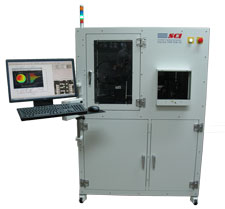Spectroscopic Ellipsometry and DUV Multi-Angle Polarized Reflectometry
The FilmTek™ 2000 PAR-SE combined metrology line is our most advanced benchtop metrology solution, with the highest accuracy, precision, and versatility in the industry. The FilmTek™ 2000 PAR-SE was engineered to meet the needs of nearly any advanced thin film measurement application, from R&D to production.
The FilmTek™ 2000 PAR-SE combines spectroscopic ellipsometry and DUV multi-angle polarized reflectometry with a wide spectral range to meet the most challenging of measurement demands. SCI’s patented parabolic mirror technology allows for a small spot size down to 50µm, ideal for direct measurement of product wafers and patterned films.
Combining patented Multi-Angle Differential Polarimetry (MADP) and Differential Power Spectral Density (DPSD) technology, the FilmTek™ 2000 PAR-SE utilizes multi-angle polarized spectroscopic reflectometry to independently measure film thickness and index of refraction. By independently measuring index and thickness, the FilmTek™ 2000 PAR-SE is far more sensitive to changes in films, particularly films within multi-layer stacks, than existing metrology tools that rely on conventional ellipsometry or reflectometry techniques.
The FilmTek™ 2000 PAR-SE is a fully-integrated package, paired with advanced material modeling software to make even the most rigorous of measurement tasks reliable and intuitive. Both hardware and software can be easily modified to satisfy unique customer requirements.
Key Features:
- Spectroscopic ellipsometry with rotating compensator design (295nm-1700nm)
- Multi-angle, polarized spectroscopic reflection (190nm-1700nm)
- Measures film thickness and index of refraction independently
- Multi-Angle Differential Polarimetry (MADP) technology with SCI’s patented Differential Power Spectral Density (DPSD) technology
- Ideal for measuring ultra-thin films (0.03 Å repeatability on native oxide)
- Camera for imaging measurement location
- Pattern recognition
- 50 micron spot size
- Optional generalized ellipsometry (4×4 matrix generalization method) for anisotropy measurements (nx, ny, nz)
Measurement Capabilities:
FilmTek™ 2000 PAR-SE incorporates SCI’s generalized material model with advanced global optimization algorithms for simultaneous determination of:
- Multiple layer thicknesses
- Indices of refraction [ n(λ) ]
- Extinction (absorption) coefficients [ k(λ) ]
- Energy band gap [ Eg ]
- Composition (e.g., %Ge in SiGex, % Ga in GaxIn1-xAs, %Al in AlxGa1-xAs, etc.)
- Surface roughness
- Constituent, void fraction
- Crystallinity/Amorphization (e.g., degree of crystallinity of Poly-Si or GeSbTe films)
- Film gradient
Optional Features:
- Cassette to cassette wafer handling
- FOUP and SMIF compatible
- Pattern recognition (Cognex)
- SECS/GEM
| Technical Specifications | |
|---|---|
| Film thickness range: | 0Å to 150µm |
| Film thickness accuracy: | ±1.0Å for NIST traceable standard oxide 100Å to 1µm |
| Spectral range: | 190nm to 1700nm (220nm to 1000nm is standard) |
| Measurement spot size: | 25µm to 300µm (normal incidence); 2mm (70°) |
| Sample size: | 2mm to 300mm (200mm is standard) |
| Spectral resolution: | 0.3-2nm |
| Light source: | Regulated deuterium-halogen lamp (2,000 hrs lifetime) |
| Detector type: | 2048 pixel Sony linear CCD array / 512 pixel cooled Hamamatsu InGaAs CCD array (NIR) |
| Automated Stage with Auto Focus | 300mm (200mm is standard) |
| Computer: | Multi-core processor with Windows™ 10 Operating System |
| Measurement time: | <1 sec per site (e.g., oxide film) |
| Performance Specifications | |||
|---|---|---|---|
| Film(s) | Thickness | Measured Parameters | Precision (1σ) |
| Oxide / Si | 0-1000 Å | t | 0.03 Å |
| 1000-500,000 Å | t | 0.005% | |
| 1000 Å | t , n | 0.2 Å / 0.0001 | |
| 15,000 Å | t , n | 0.5 Å / 0.0001 | |
| 150,000 Å | t , n | 1.5 Å / 0.00001 | |
| Photoresist / Si | 200-10,000 Å | t | 0.02% |
| 500-10,000 Å | t , n | 0.05% / 0.0002 | |
| Nitride / Si | 200-10,000 Å | t | 0.02% |
| 500-10,000 Å | t , n | 0.05% / 0.0005 | |
| Polysilicon / Oxide / Si | 200-10,000 Å | t Poly , t Oxide | 0.2 Å / 0.1 Å |
| 500-10,000 Å | t Poly , t Oxide | 0.2 Å / 0.0005 | |

